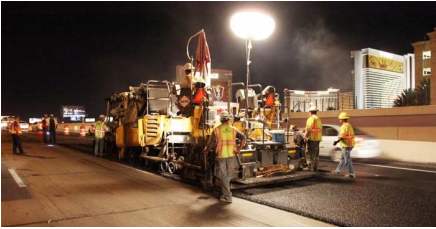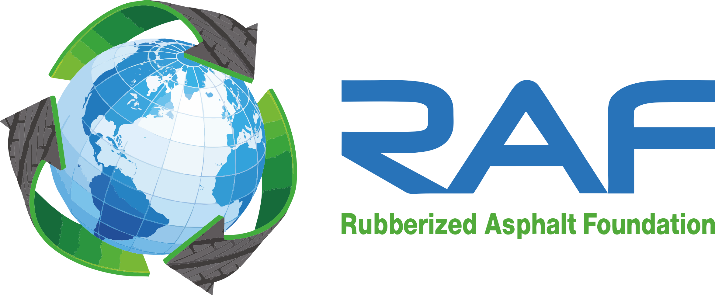In October of 2011, the Nevada Department of Transportation (NDOT) completed a
rehabilitation project on Interstate 15 (I-15) in Las Vegas, Nevada that included placing
an asphalt-rubber asphalt concrete friction course (AR-ACFC). The 5.5-mile (8.85-km)
section of I-15 is located between Nevada State Route 593, which is Tropicana Avenue,
and I-515, which is the Las Vegas Expressway. The existing Portland cement concrete
pavement in both directions needed rehabilitation because it had spalled and chipped
over many years and also had “ghost striping,” which are the faint imprints of old lane
markings left by construction crews. The pavement was rehabilitated by repairing the
spalls and chipped areas, sealing all joints, removing all lane markings, cold milling, and
placing a 1-inch (25.4-mm) thick AR-ACFC. The cost of the entire project was nearly
$7.3 million.

This section of I-15 has
up to six travel lanes
and two shoulders, and
carries up to 270,000
vehicles daily.
The asphalt-rubber mixture used in the friction course was designed and placed
according to Arizona Department of Transportation (ADOT) Specification 414. ADOT
began using asphalt-rubber in the 1960s and has extensive experience with AR-ACFC.
While planning to rehabilitate I-15, Nevada officials went to Arizona to learn more about
asphalt-rubber and AR-ACFC. NDOT also worked together with ADOT when doing the
mixture design for I-15. The primary paving contractor was Fisher Sand & Gravel,
which is based in North Dakota, but has companies in several states including Arizona
and Nevada. They have done extensive work with asphalt-rubber in Arizona.
The asphalt cement before being modified by the ground tire rubber met national
specifications for a PG 64-16. The ground tire rubber met specifications for a Type B
Rubber which requires that 100 percent of the rubber particles pass the number 30
sieve (0.600 mm) and 40 to 60 percent of the rubber particles pass the number 50 sieve
(0.300 mm). The ADOT procedure requires a minimum of 20-percent ground tire rubber
by weight of the asphalt cement, which is blended with the asphalt cement in a reaction
tank for at least one hour at a temperature in the range of 325 to 375 F (163 to 191 C).
For the I-15 project, the ground tire rubber content was 25.8 percent, and the asphaltrubber binder content of the AR-ACFC was 9.7 percent which is designed to provide
flexibility and long-term durability.
Approximately 26,430 tons of AR-ACFC was placed, which meant 660 tons of ground
tire rubber was used, or approximately 56,000 recycled tires. Besides “preventing tires
from going into landfills,” NDOT stated they chose an AR-ACFC for this project because
by using it, “ride smoothness nearly doubles and roadway surface deterioration
reduces” and “asphalt-rubber effectively cuts road noise by more than half.” NDOT also
stated they have used asphalt rubber in the past, and in 2008, a rehabilitation project on
I-515 in Henderson, which is near Las Vegas, won a “Quieter Leadership Pavement
Award.” In that project, approximately 30,000 recycled tires were incorporated into the
mixture. NDOT has been monitoring this section of I-515 for four years has been
pleased with its performance and is now monitoring I-15.
